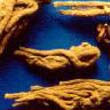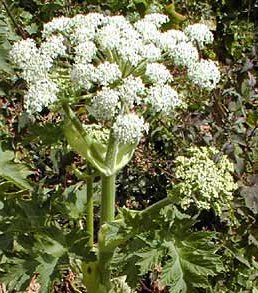Growing Angelica Sinensis or Chinese Angelica

Angelica sinensis is a perennial that generally grows up to 3 feet tall. As you would expect from a plant native to China, it is hardy to Zone 7. The plant flowers in early fall and produces seeds during September and October. Angelica sinensis can be grown in semi-shade and prefers moist soil. The stems are purplish with 12-36 five-petal, white flowers that form on umbrels.
Angelica sinensis is grown for the root of the plant. It is indigenous to China where it is commonly known as “dong quai.” It is also sometimes referred to “female ginseng” as it is has been widely used in traditional Chinese medicine for gynecological ailments much like ginseng is used for sexual dysfunction in men.
Traditional Uses of Angelica Sinensis
Angelica sinensis has been used in traditional Chinese, Korean and Japanese medicine for thousands of years. It is one of the more popular medicinal herbs used in China. They use it to treat painful menstruation, to aid recovery after childbirth and fatigue or low vitality. It is also used for conditions thought to be related to the blood or xue such as headaches, high blood pressure, infections, inflammation, and nerve pain.
Dong quai, which means ‘return to order’, is used for its restorative properties, often in combination with other herbs.
The Chinese have used the herb during pregnancy. They believe it provides for a more healthy pregnancy and an easier birth. Yet, western medicine recommends against the use of Dong quai by pregnant or lactating women.
One source mentioned Dong quai as a way to combat alcoholism since it produces a disgust for liquor.
Modern Medicine Contradicts Itself About Don Quai Usage
The National Institutes of Health, The Mayo Clinic and The World Health Organization offer contradictory and conflicting information about the medicinal uses of Angelica sinensis.
The World Health Organization (WHO) on Dong Quai
The WHO clearly states that there are no medicinal uses of Dong quai supported by clinical data. They do mention a number of animal studies that indicate that Radix Angelicae Sinensis or the dried roots of Angelica sinensis has been shown to impact bladder, intestine and uterus muscles and increase coronary blood flow in dogs. It was also shown to have an effect on arrhythmias and blood coagulation.
They advise patients taking anticoagulant therapies, are pregnant or are lactating to consult their physician before taking Radix Angelicae Sinensis. Among a small study of 40 people, who were given Radix Angelicae Sinensis for 30 days (240 ml/person by IV), there were no adverse reactions reported. However, the WHO did mention that some patients may suffer headache as a result of using the herb which would appear to be in direct conflict with one of the traditional uses of Chinese angelica.
The Mayo Clinic on Dong Quai
The Mayo Clinic website mentions that it remains unclear if Chinese angelica impacts the body like estrogen. They also mention that most of the clinical studies on the herb were either flawed in their design or had insignificant results as they utilized herbal blends where Dong quai was only one of several ingredients.
NIH & The Medicinal Qualities of Dong Quai
According to the United States National Institutes of Health, continued use of dong quai can lead to skin sensitivity and does contain some chemicals that are thought to be carcinogens. Several sources mentioned a compound of the herb being a possible carcinogen, yet is is sometimes used in Eastern Medicine to alleviate they side effects associated with chemotherapy.
They list it as “possibly ineffective” for menopausal symptoms and as lacking sufficient evidence that it helps for other gynecological ailments, high blood pressure, joint aches and pains and other conditions. They warn that it can act like estrogen which can increase the risk of blood clotting in people with a Protein S deficiency. They also warn against the possibility that it can slow blood clotting. Both of those warnings are obviously contradictory.
When NIH discusses interactions between Chinese Angelica or dong quai and medications, they most frequently mention that it slows blood clotting and may increase chances of bruising and bleeding if taking it with anticoagulant drugs and a number of the common NSAIDs. Other herbs that they suggest may slow blood clotting and therefore should not be taken in conjunction with dong quai are angelica, clove, danshen (red sage), garlic, ginger, gingko, panax ginseng, poplar, red clover, willow and “others”. (Unfortunately, they actually had in their information “and others” so do not assume because an herb is not listed here that it might not be a good idea to mix it with dong quai.)
Conclusions on Medicinal Uses of Angelica Sinensis
First let me say, I know nothing about Angelica Sinensis other than what I’ve read in preparing this article. The Chinese have been using Dong quai for over 4,000 years to treat a variety of ailments. Both the traditional uses and modern evaluations of this medicinal herb do seem to contradict each other. For example, an herb that eases the muscle contractions of childbirth but also may be an anti-coagulant would seem to offer an inherent risk to its use during pregnancy.
It would seem the Chinese do not use it alone but in combination with other herbs which may ultimately hold the key to whether or not it is truly effective and safe. It would seem additional research and careful monitoring are key to its use as a medicinal herb.
Most sources, including those discussing traditional Chinese medicine, state that the herb root is an anti-coagulant. It seems that anyone who uses this medicinal herb should not do anything that would increase their chances of injury.
Both the WHO and NIH mentioned that Dong quai can cause photo-sensitivity. Anyone using this herb may be well-advised to assume that is indeed the case and take proper precautions when exposed to direct sunlight.
Additional Angelica Information.

If you are interested in growing angelica, you might want to take a moment to check out our Angelica Companion Planting Guide to learn what other herb should never be planted with angelica as well as which plants grow well with angelica archangelica.
Modern medicine likes to isolate components and ignore the fact that plants have MANY components that work in conjunction with each other. So, when the offer that this, that or the other component is known to cause cancer they ignore the fact that other components in the plant can and do counter that possible effect. In addition, they forget to mention that the negative effect is usually caused by excessive use or excessive dosage of that particular component. Comfrey studies are rife with this flaw in their studies.
When I write these articles, I tend to take a more of a Trivial Pursuit approach – ‘hey, did you know….’ I am far from qualified to do more than that. That said, I agree wholeheartedly with your comments. I wish more clinicians took a more balanced approach of using herbs and other supplements whenever possible and medications only as a last resort. Though I suspect, like you, some of the studies are designed to have negative outcomes.